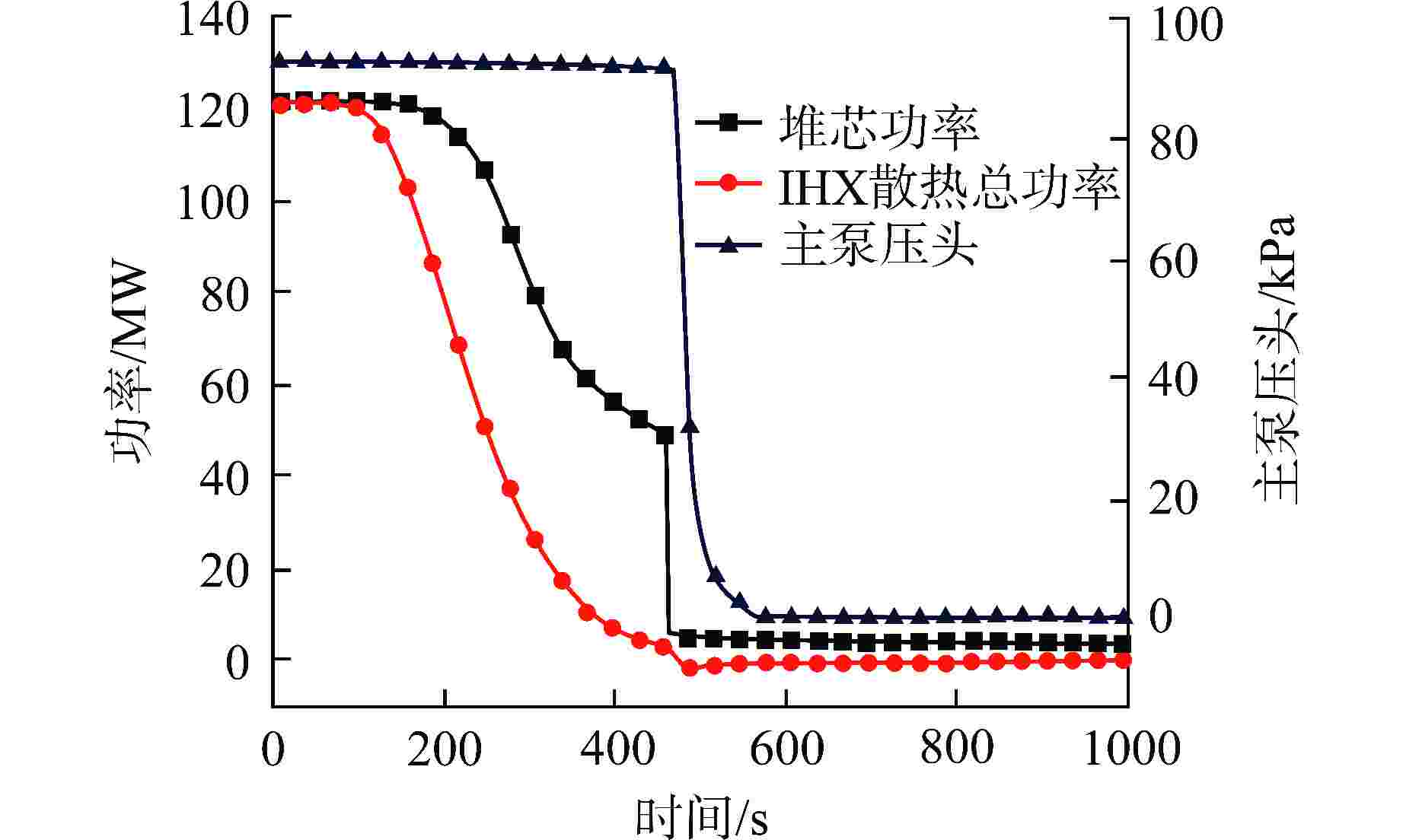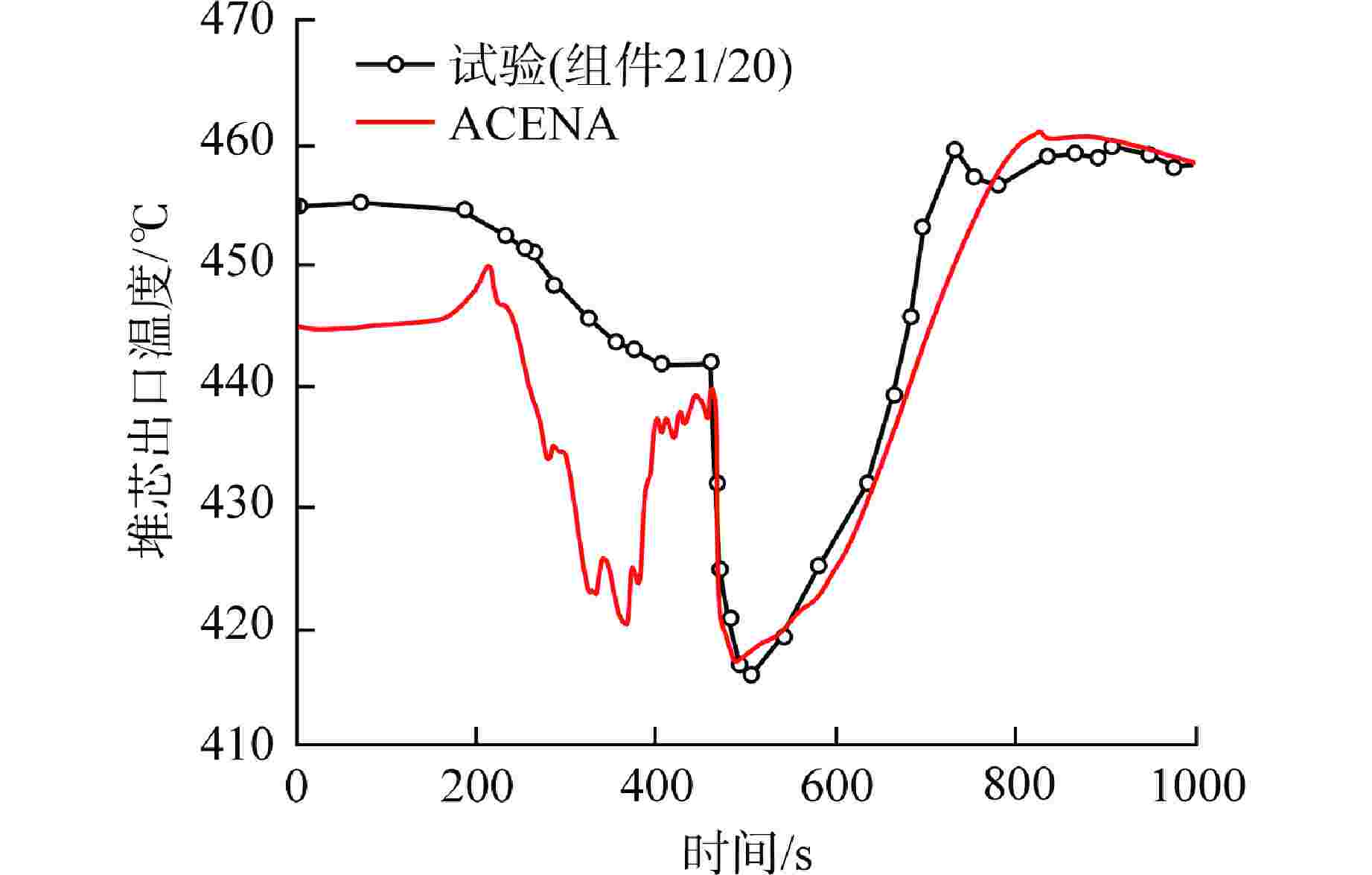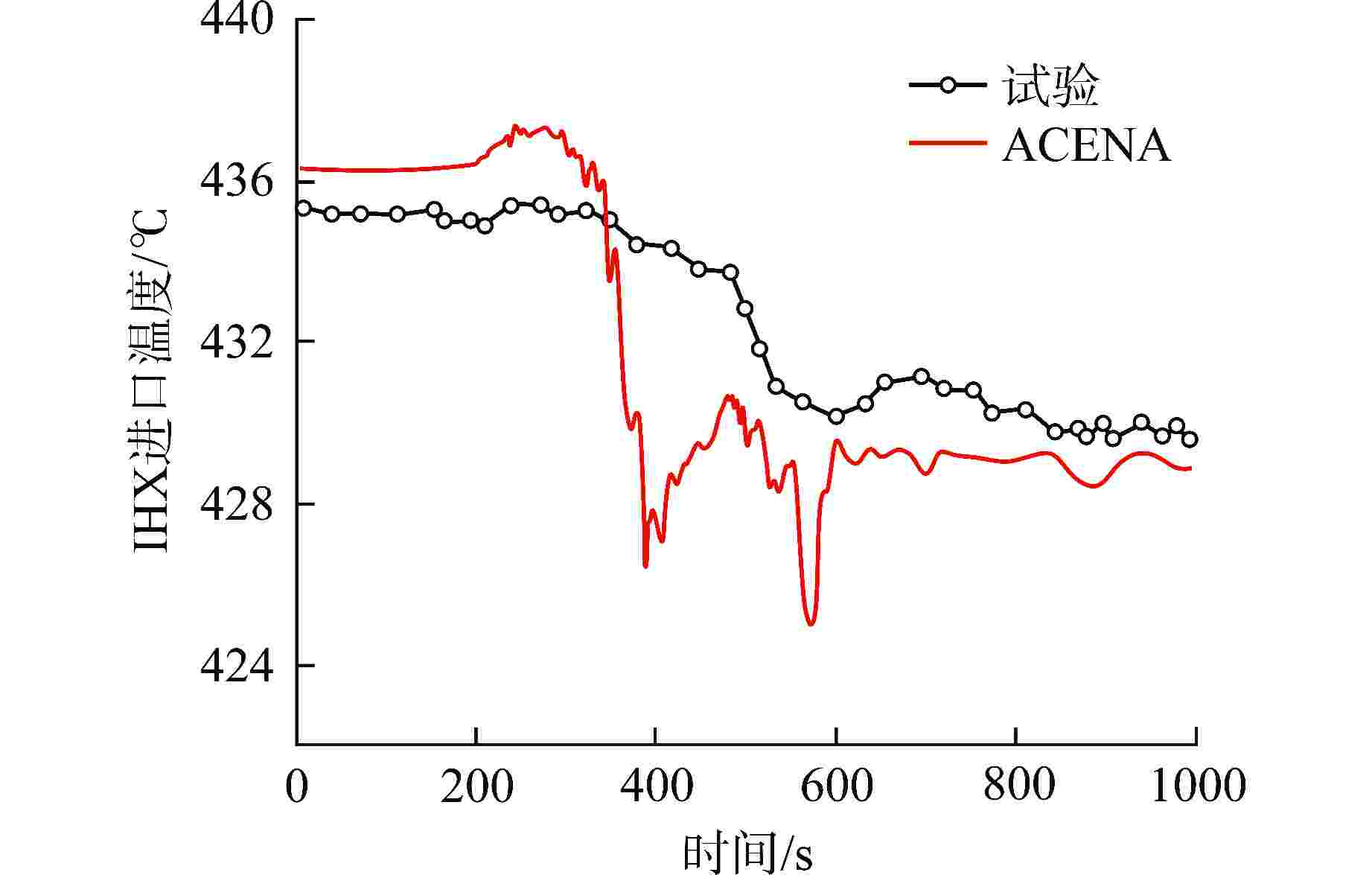Numerical Simulation of the Natural Circulation Test of PHENIX Reactor by ACENA
-
摘要: 自然循环余热排出是池式钠冷快堆重要的非能动安全特征,但同时也给钠冷快堆的设计与安全分析带来了新的问题和挑战。在全厂断电事故下,钠冷快堆能否建立起自然循环,自然循环能否带走堆芯的衰变热,是反应堆安全分析的重要内容。为验证液态金属堆事故分析程序ACENA在钠冷快堆自然循环余热排出的模拟计算的可靠性,对法国原子能委员会(CEA)在池式钠冷快堆凤凰堆寿期末开展的自然循环试验开展建模分析。模型中的钠池采用二维有限差分方法来考虑热分层对自然循环的影响。验证结果表明,ACENA能够准确分析钠冷快堆由强迫循环转变为自然循环的过程并对关键参数进行准确的预测,能够计算钠池内的热分层现象,具备钠冷快堆自然循环余热排出的计算能力。Abstract: Natural circulation decay heat removal is is an important passive safety feature of pool-type sodium-cooled fast reactor (SFR), but it also brings new problems and challenges to the design and safety analysis of SFR. Whether the natural cycle can be established and whether the natural cycle can take away the decay heat of the core is an important part of the reactor safety analysis under station black-out accident (SBO). In order to verify the reliability of the liquid metal accident analysis code ACENA in the simulation of natural cycle decay heat removal in SFR, the natural circulation test conducted by the French Alternative Energies and Atomic Energy Commission (CEA) at the end of the life of pool-type sodium-cooled fast reactor PHENIX was modeled and analyzed. The effect of thermal stratification on natural circulation was considered by two-dimensional finite difference method in sodium pool. The verification results show that ACENA can accurately analyze the process of forced circulation to natural circulation and accurately predict the key parameters. The code can also calculate the thermal stratification phenomenon in the sodium pool, and has the calculation capacity of natural circulation decay heat removal.
-
Key words:
- Sodium-cooled fast reactor /
- Natural circulation /
- Decay heat removal /
- PHENIX /
- ACENA
-
表 1 凤凰堆在120 MW下的主要初始参数
Table 1. Main Initial Parameters of PHENIX Reactor at 120 MW
参数 参数值 堆芯功率/MW 120 堆芯流量/(kg·s−1) 1284 堆芯(进/出)口温度/℃ 358/432 IHX一次侧(进/出)口温度/℃ 432/360 IHX一次侧流量/(kg·s−1) 321 IHX二次侧(进/出)口温度/℃ 308/432 IHX二次侧流量/(kg·s−1) 190 主冷却剂泵转速/(r·min−1) 350 二回路泵转速/(r·min−1) 390 表 2 凤凰堆自然循环试验序列
Table 2. Main Actions of the PHENIX Natural Circulation Test
时刻 动作 0 s 关闭SG给水,2个二回路SG蒸干,泵转速
不变458 s 紧急停堆,2个二回路泵的转速在1 min内自动下降到110 r/min 466 s 关闭3个主泵,主泵转速逐渐降至0 r/min 4080 s 2个二回路泵的转速下降至100 r/min(备用
电机)10320 s 打开SG套筒的空气自然循环冷却开始 24300 s SG套筒的空气自然循环冷却结束,试验结束 表 3 120 MW稳态结果对比
Table 3. Comparison of Steady State Result at 120 MW
参数 试验值 ACENA 绝对偏差 堆芯进口温度/℃ 358 364.1 6.1 堆芯出口温度/℃ 432 436.3 4.3 IHX一次侧进口温度/℃ 432 436.3 4.3 IHX一次侧出口温度/℃ 360 365.5 5.5 冷池温度/℃ 358 362.0 4.0 堆芯质量流量/(kg·s−1) 1284 1282.8 −1.2 -
[1] TENCHINE D. Some thermal hydraulic challenges in sodium cooled fast reactors[J]. Nuclear Engineering and Design, 2010, 240(5): 1195-1217. doi: 10.1016/j.nucengdes.2010.01.006 [2] ONO A, KAMIDE H, KOBAYASHI J, et al. An experimental study on natural circulation decay heat removal system for a loop type fast reactor[J]. Journal of Nuclear Science and Technology, 2016, 53(9): 1385-1396. doi: 10.1080/00223131.2015.1121844 [3] WATANABE O, OYAMA K, ENDO J, et al. Development of an evaluation methodology for the natural circulation decay heat removal system in a sodium cooled fast reactor[J]. Journal of Nuclear Science and Technology, 2015, 52(9): 1102-1121. doi: 10.1080/00223131.2014.994049 [4] WANG S B, ZHANG D L, LIU Y P, et al. An experiment‐based validation of a system code for prediction of passive natural circulation in sodium‐cooled fast reactor[J]. International Journal of Energy Research, 2021, 45(8): 12093-12109. doi: 10.1002/er.6103 [5] IAEA. Benchmark analyses on the natural circulation test performed during the PHENIX end-of-life experiments: IAEA-TECDOC-1703[R]. Vienna: International Atomic Energy Agency, 2013. [6] TENCHINE D, PIALLA D, FANNING T H, et al. International benchmark on the natural convection test in Phenix reactor[J]. Nuclear Engineering and Design, 2013, 258: 189-198. doi: 10.1016/j.nucengdes.2013.02.010 [7] TENCHINE D, PIALLA D, GAUTHÉ P, et al. Natural convection test in Phenix reactor and associated CATHARE calculation[J]. Nuclear Engineering and Design, 2012, 253: 23-31. doi: 10.1016/j.nucengdes.2012.08.001 [8] 齐少璞,杨红义,杨晓燕,等. 基于FR-Sdaso的法国凤凰堆寿期末自然循环实验分析[J]. 原子能科学技术,2020, 54(2): 273-280. doi: 10.7538/yzk.2019.youxian.0120 [9] YUE N N, ZHANG D L, CHEN J, et al. The development and validation of the inter-wrapper flow model in sodium-cooled fast reactors[J]. Progress in Nuclear Energy, 2018, 108: 54-65. doi: 10.1016/j.pnucene.2018.05.007 [10] JEONG H Y, HA K S, CHOI C W. Multi-dimensional pool analysis of Phenix end-of-life natural circulation test with MARS-LMR code[J]. Annals of Nuclear Energy, 2014, 63: 309-316. doi: 10.1016/j.anucene.2013.08.010 [11] MOCHIZUKI H, KIKUCHI N, LI S. Computation of natural convection test at Phenix reactor using the NETFLOW++ code[J]. Nuclear Engineering and Design, 2013, 262: 1-11. doi: 10.1016/j.nucengdes.2013.03.056 [12] ZHOU C, HUBER K, CHENG X. Validation of the modified ATHLET code with the natural convection test of the PHENIX reactor[J]. Annals of Nuclear Energy, 2013, 59: 31-46. doi: 10.1016/j.anucene.2013.03.035 [13] WAHNON S S P, AMMIRABILE L, KLOOSTERMAN J L, et al. Multi-physics models for design basis accident analysis of sodium fast reactors. Part I: Validation of three-dimensional TRACE thermal-hydraulics model using Phenix end-of-life experiments[J]. Nuclear Engineering and Design, 2018, 331: 331-341. doi: 10.1016/j.nucengdes.2018.02.038 [14] PARTHASARATHY U, SUNDARARAJAN T, BALAJI C, et al. Decay heat removal in pool type fast reactor using passive systems[J]. Nuclear Engineering and Design, 2012, 250: 480-499. doi: 10.1016/j.nucengdes.2012.05.014 [15] BAVIÈRE R, TAUVERON N, PERDU F, et al. A first system/CFD coupled simulation of a complete nuclear reactor transient using CATHARE2 and TRIO_U. Preliminary validation on the Phénix Reactor Natural Circulation Test[J]. Nuclear Engineering and Design, 2014, 277: 124-137. doi: 10.1016/j.nucengdes.2014.05.031 [16] PIALLA D, TENCHINE D, LI S, et al. Overview of the system alone and system/CFD coupled calculations of the PHENIX Natural Circulation Test within the THINS project[J]. Nuclear Engineering and Design, 2015, 290: 78-86. doi: 10.1016/j.nucengdes.2014.12.006 [17] IAEA. Benchmark analyses on the control rod withdrawal tests performed during the PHÉNIX end-of-life experiments: IAEA-TECDOC-1742[R]. Vienna: International Atomic Energy Agency, 2014. [18] CHEN Y T, ZHANG D L, LIANG Y, et al. Preliminary development and validation of ACENA code for heavy liquid metal-gas two phase flow simulation[J]. Annals of Nuclear Energy, 2021, 161: 108452. doi: 10.1016/j.anucene.2021.108452 [19] 林悦,张大林,陈宇彤,等. 熔融铅铋与水相互作用热工水力特性研究[J]. 原子能科学技术,2023, 57(S1): 56-66. -






 下载:
下载:








